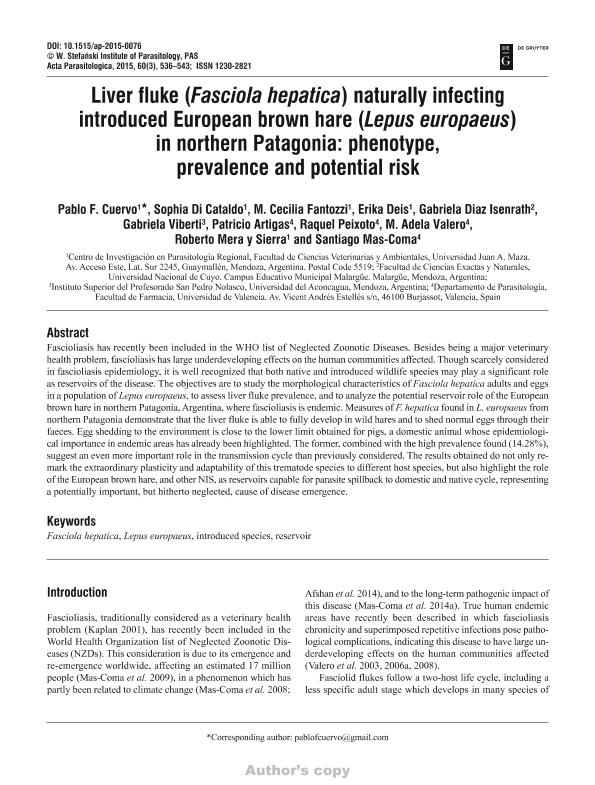Mostrar el registro sencillo del ítem
dc.contributor.author
Cuervo Bustamante, Pablo Fernando

dc.contributor.author
Cataldo, Sophia Di
dc.contributor.author
Fantozzi, María Cecilia

dc.contributor.author
Deis, Erika

dc.contributor.author
Diaz Isenrath, Gabriela Beatriz

dc.contributor.author
Viberti, Gabriela
dc.contributor.author
Artigas, Patricio
dc.contributor.author
Peixoto, Raquel
dc.contributor.author
Valero, M. Adela
dc.contributor.author
Mera y Sierra, Roberto

dc.contributor.author
Mas-coma, Santiago

dc.date.available
2018-03-23T14:02:11Z
dc.date.issued
2015-09
dc.identifier.citation
Cuervo Bustamante, Pablo Fernando; Cataldo, Sophia Di; Fantozzi, María Cecilia; Deis, Erika; Diaz Isenrath, Gabriela Beatriz; et al.; Liver fluke (Fasciola hepatica) naturally infecting introduced European brown hare (Lepus europaeus) in northern Patagonia: Phenotype, prevalence and potential risk; Versita; Acta Parasitologica; 60; 3; 9-2015; 536-543
dc.identifier.issn
1230-2821
dc.identifier.uri
http://hdl.handle.net/11336/39742
dc.description.abstract
Fascioliasis has recently been included in the WHO list of Neglected Zoonotic Diseases. Besides being a major veterinary health problem, fascioliasis has large underdeveloping effects on the human communities affected. Though scarcely considered in fascioliasis epidemiology, it is well recognized that both native and introduced wildlife species may play a significant role as reservoirs of the disease. The objectives are to study the morphological characteristics of Fasciola hepatica adults and eggs in a population of Lepus europaeus, to assess liver fluke prevalence, and to analyze the potential reservoir role of the European brown hare in northern Patagonia, Argentina, where fascioliasis is endemic. Measures of F. hepatica found in L. europaeus from northern Patagonia demonstrate that the liver fluke is able to fully develop in wild hares and to shed normal eggs through their faeces. Egg shedding to the environment is close to the lower limit obtained for pigs, a domestic animal whose epidemiological importance in endemic areas has already been highlighted. The former, combined with the high prevalence found (14.28%), suggest an even more important role in the transmission cycle than previously considered. The results obtained do not only remark the extraordinary plasticity and adaptability of this trematode species to different host species, but also highlight the role of the European brown hare, and other NIS, as reservoirs capable for parasite spillback to domestic and native cycle, representing a potentially important, but hitherto neglected, cause of disease emergence.
dc.format
application/pdf
dc.language.iso
eng
dc.publisher
Versita

dc.rights
info:eu-repo/semantics/openAccess
dc.rights.uri
https://creativecommons.org/licenses/by-nc-sa/2.5/ar/
dc.subject
Fasciola Hepatica
dc.subject
Introduced Species
dc.subject
Lepus Europaeus
dc.subject
Reservoir
dc.subject.classification
Otras Ciencias Biológicas

dc.subject.classification
Ciencias Biológicas

dc.subject.classification
CIENCIAS NATURALES Y EXACTAS

dc.title
Liver fluke (Fasciola hepatica) naturally infecting introduced European brown hare (Lepus europaeus) in northern Patagonia: Phenotype, prevalence and potential risk
dc.type
info:eu-repo/semantics/article
dc.type
info:ar-repo/semantics/artículo
dc.type
info:eu-repo/semantics/publishedVersion
dc.date.updated
2018-03-21T16:54:18Z
dc.identifier.eissn
1896-1851
dc.journal.volume
60
dc.journal.number
3
dc.journal.pagination
536-543
dc.journal.pais
Polonia

dc.journal.ciudad
Varsovia
dc.description.fil
Fil: Cuervo Bustamante, Pablo Fernando. Universidad ; Argentina. Consejo Nacional de Investigaciones Científicas y Técnicas. Centro Científico Tecnológico Conicet - Santa Fe. Instituto de Ciencias Veterinarias del Litoral. Universidad Nacional del Litoral. Facultad de Ciencias Veterinarias. Instituto de Ciencias Veterinarias del Litoral; Argentina
dc.description.fil
Fil: Cataldo, Sophia Di. Universidad ; Argentina
dc.description.fil
Fil: Fantozzi, María Cecilia. Universidad ; Argentina. Consejo Nacional de Investigaciones Científicas y Técnicas. Centro Científico Tecnológico Conicet - Santa Fe. Instituto de Ciencias Veterinarias del Litoral. Universidad Nacional del Litoral. Facultad de Ciencias Veterinarias. Instituto de Ciencias Veterinarias del Litoral; Argentina
dc.description.fil
Fil: Deis, Erika. Universidad ; Argentina
dc.description.fil
Fil: Diaz Isenrath, Gabriela Beatriz. Universidad Nacional de Cuyo. Facultad de Ciencias Exactas y Naturales; Argentina. Consejo Nacional de Investigaciones Científicas y Técnicas; Argentina
dc.description.fil
Fil: Viberti, Gabriela. Universidad del Aconcagua; Argentina
dc.description.fil
Fil: Artigas, Patricio. Universidad de Valencia; España
dc.description.fil
Fil: Peixoto, Raquel. Universidad de Valencia; España
dc.description.fil
Fil: Valero, M. Adela. Universidad de Valencia; España
dc.description.fil
Fil: Mera y Sierra, Roberto. Universidad ; Argentina
dc.description.fil
Fil: Mas-coma, Santiago. Universidad de Valencia; España
dc.journal.title
Acta Parasitologica

dc.relation.alternativeid
info:eu-repo/semantics/altIdentifier/doi/http://dx.doi.org/10.1515/ap-2015-0076
dc.relation.alternativeid
info:eu-repo/semantics/altIdentifier/url/https://www.degruyter.com/view/j/ap.2015.60.issue-3/ap-2015-0076/ap-2015-0076.xml
Archivos asociados
